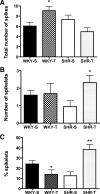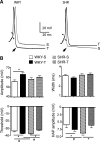Exercise training normalizes an increased neuronal excitability of NTS-projecting neurons of the hypothalamic paraventricular nucleus in hypertensive rats
- PMID: 22357793
- PMCID: PMC3362275
- DOI: 10.1152/jn.00884.2011
Exercise training normalizes an increased neuronal excitability of NTS-projecting neurons of the hypothalamic paraventricular nucleus in hypertensive rats
Abstract
Elevated sympathetic outflow and altered autonomic reflexes, including impaired baroreflex function, are common findings observed in hypertensive disorders. Although a growing body of evidence supports a contribution of preautonomic neurons in the hypothalamic paraventricular nucleus (PVN) to altered autonomic control during hypertension, the precise underlying mechanisms remain unknown. Here, we aimed to determine whether the intrinsic excitability and repetitive firing properties of preautonomic PVN neurons that innervate the nucleus tractus solitarii (PVN-NTS neurons) were altered in spontaneously hypertensive rats (SHR). Moreover, given that exercise training is known to improve and/or correct autonomic deficits in hypertensive conditions, we evaluated whether exercise is an efficient behavioral approach to correct altered neuronal excitability in hypertensive rats. Patch-clamp recordings were obtained from retrogradely labeled PVN-NTS neurons in hypothalamic slices obtained from sedentary (S) and trained (T) Wistar-Kyoto (WKY) and SHR rats. Our results indicate an increased excitability of PVN-NTS neurons in SHR-S rats, reflected by an enhanced input-output function in response to depolarizing stimuli, a hyperpolarizing shift in Na(+) spike threshold, and smaller hyperpolarizing afterpotentials. Importantly, we found exercise training in SHR rats to restore all these parameters back to those levels observed in WKY-S rats. In several cases, exercise evoked opposing effects in WKY-S rats compared with SHR-S rats, suggesting that exercise effects on PVN-NTS neurons are state dependent. Taken together, our results suggest that elevated preautonomic PVN-NTS neuronal excitability may contribute to altered autonomic control in SHR rats and that exercise training efficiently corrects these abnormalities.
Figures





References
-
- Aghajanian GK, Rasmussen K. Intracellular studies in the facial nucleus illustrating a simple new method for obtaining viable motoneurons in adult rat brain slices. Synapse 3: 331–338, 1989 - PubMed
-
- Allen AM. Inhibition of the hypothalamic paraventricular nucleus in spontaneously hypertensive rats dramatically reduces sympathetic vasomotor tone. Hypertension 39: 275–280, 2002 - PubMed
-
- Alvarez GE, Halliwill JR, Ballard TP, Beske SD, Davy KP. Sympathetic neural regulation in endurance-trained humans: fitness vs. fatness. J Appl Physiol 98: 498–502, 2005 - PubMed
-
- Amaral SL, Michelini LC. Effect of gender on training-induced vascular remodeling in SHR. Braz J Med Biol Res 44: 814–826, 2011 - PubMed
-
- Amaral SL, Zorn TM, Michelini LC. Exercise training normalizes wall-to-lumen ratio of the gracilis muscle arterioles and reduces pressure in spontaneously hypertensive rats. J Hypertens 18: 1563–1572, 2000 - PubMed
Publication types
MeSH terms
Grants and funding
LinkOut - more resources
Full Text Sources
Other Literature Sources
Medical

